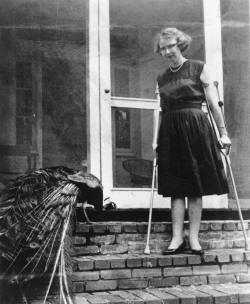

Queer Places:
207 E Charlton St, Savannah, GA 31401
Iowa
Writers' Workshop, Iowa City, IA 52245
Yaddo, 312 Union Ave, Saratoga Springs, NY 12866
Andalusia Farm, 2628 N Columbia St, Milledgeville, GA 31061
 Mary Flannery O'Connor (March 25, 1925 – August 3, 1964) was an American novelist, short story writer and essayist. She wrote two novels and 32 short stories, as well as a number of reviews and commentaries.
She was a Southern writer who often wrote in a sardonic Southern Gothic style and relied heavily on regional settings and grotesque characters, often in violent situations. The unsentimental acceptance or rejection of the limitations or imperfections or differences of these characters (whether attributed to disability, race, crime, religion or sanity) typically underpins the drama.[2]
Her writing reflected her Roman Catholic faith and frequently examined questions of morality and ethics. Her posthumously compiled Complete Stories won the 1972 U.S. National Book Award for Fiction and has been the subject of enduring praise.
Mary Flannery O'Connor (March 25, 1925 – August 3, 1964) was an American novelist, short story writer and essayist. She wrote two novels and 32 short stories, as well as a number of reviews and commentaries.
She was a Southern writer who often wrote in a sardonic Southern Gothic style and relied heavily on regional settings and grotesque characters, often in violent situations. The unsentimental acceptance or rejection of the limitations or imperfections or differences of these characters (whether attributed to disability, race, crime, religion or sanity) typically underpins the drama.[2]
Her writing reflected her Roman Catholic faith and frequently examined questions of morality and ethics. Her posthumously compiled Complete Stories won the 1972 U.S. National Book Award for Fiction and has been the subject of enduring praise.
O'Connor was born on March 25, 1925, in Savannah, Georgia, the only child of Edward Francis O'Connor, a real estate agent, and Regina Cline, who were both of Irish descent.[3][4] As an adult, she remembered herself as a "pigeon-toed child with a receding chin and a you-leave-me-alone-or-I'll-bite-you complex".[5] The Flannery O'Connor Childhood Home museum is located at 207 E. Charlton Street on Lafayette Square. In 1940, O'Connor and her family moved to Milledgeville, Georgia, where they initially lived with her mother's family at the so-called 'Cline mansion', in town.[6] In 1937, her father had been diagnosed with systemic lupus erythematosus; it led to his eventual death on February 1, 1941,[7] and O'Connor and her mother continued to live in Milledgeville.[8] In 1951, they moved to Andalusia Farm,[9] which is now a museum dedicated to O'Connor's work.
O'Connor attended Peabody High School, where she worked as the school newspaper's art editor and from which she graduated in 1942.[10] She entered Georgia State College for Women (now Georgia College & State University) in an accelerated three-year program and graduated in June 1945 with a B.A. in sociology and English literature. While at Georgia College, she produced a significant amount of cartoon work for the student newspaper.[11][12] Many critics have claimed that the idiosyncratic style and approach of these early cartoons shaped her later fiction in important ways.[13][14] In 1946, she was accepted into the prestigious Iowa Writers' Workshop at the University of Iowa, where she first went to study journalism. Workshop director Paul Engle was the first to read and comment on the initial drafts of what would become Wise Blood. She received an M.F.A. from the University of Iowa in 1947.[16] During the summer of 1948, O'Connor continued to work on Wise Blood at Yaddo, an artists' community in Saratoga Springs, New York, where she also completed several short stories.[17]

207 E Charlton St, by Elisa Rolle
By the summer of 1952, O'Connor was diagnosed with systemic lupus erythematosus (lupus),[25] as her father had been before her.[7] She remained for the rest of her life on Andalusia.[15] She hosted several visitors, including Jesuit priest Fr. James McCown, who became a close friend and spiritual mentor, and writer Katherine Anne Porter. O'Connor lived for twelve years after her diagnosis, seven years longer than expected. Her daily routine was to attend Mass, write in the morning, then spend the rest of the day recuperating and reading. Despite the debilitating effects of the steroid drugs used to treat O'Connor's lupus, she nonetheless made over sixty appearances at lectures to read her works.[15] In the PBS documentary, Flannery, the writer Alice McDermott explains the impact lupus had on O'Connor's work, saying, "It was the illness, I think, which made her the writer she is."[26]
In 1955, Betty Hester, an Atlanta file clerk, wrote O'Connor a letter expressing admiration for her work.[31] Hester's letter drew O'Connor's attention,[32] and they corresponded frequently.[31] For The Habit of Being, Hester provided Fitzgerald with all the letters she received from O'Connor but requested that her identity be kept private; she was identified only as "A."[22] The complete collection of the unedited letters between O'Connor and Hester was unveiled by Emory University in May 2007; the letters had been given to the university in 1987 with the stipulation that they not be released to the public for 20 years.[31][21]
O'Connor completed more than two dozen short stories and two novels while living with lupus. She died on August 3, 1964, at the age of 39 in Baldwin County Hospital.[15] Her death was caused by complications from a new attack of lupus following surgery for a uterine fibroid.[15] She was buried in Milledgeville, Georgia,[27] at Memory Hill Cemetery.
My published books: